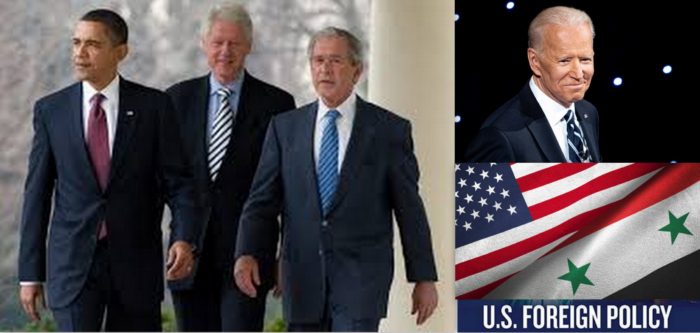Syria has been a pawn in the balance of power between the western order of nations and the communist bloc led by Russia, which has been using Iran as its proxy in the region. The Gulf States have generally had antagonistic relations with Syria due to the Shia-Sunni divide, but in this dynamic, the situation looks to be improving in favour of Syria, after the ISIS to a large extent getting subdued.
The relation between the US and Syria has seen numerous tumultuous ups & downs through the decades. On February 25, 2021, US military carried out strikes, using 500-lb Joint Direct Attack Munition-guided precision bombs in Eastern Syria on facilities at seven sites, which were backed by Iran-militia including Kata’ib Hezbollah & Kata’ib Sayyid al-Shuhada, after rocket attacks on US troops in Iraq. It was reported that the strikes had hit three trucks loaded with munitions coming from Iraq into Syria. Prior to this, Iran had carried out strikes on US & coalition forces in Al Asad Air Base in Iraq in 2020, using short-range ballistic missiles carrying 1,000- to 2,000-pound munitions, in retaliation to the US military strike (ordered by Trump) on January 03, 2020 that had killed Major General Qassem Soleimani, a top official in the Islamic Revolutionary Guard Corps. Qassem Soleimani, who was a commander of Quds forces, one of the five branches of the IRGC, was killed in a targeted US drone strike on January 03, 2020, after Trump had designated him as a terrorist.
Tracking of US-Syria relations
Though the relations between the US and Syria have origins in 1835, the two countries at present are technically cut off in the diplomatic domain. The relations have seen numerous bumps in the late twentieth century. In 1986, former US Secretary of State Alexander Haig had termed Syria as the world’s worst state sponsor of terrorism. Through the later part of the Reagan-era, the US-Syria relations were in turbulent waters. Few years later, as a part of a multilateral coalition forces in the Gulf War, Syria cooperated with the US in Operation Desert Storm. The Middle-East peace conference in 1991 saw the participation of Syria, when Hafez al Assad had accepted the invitation from the then President of the US, George H W Bush. That further led to the engagement of Syria in bilateral negotiations with Israel under the Madrid conference of 1991. The conference, hosted by Spain & co-sponsored by US and the then-USSR, was an attempt at peace negotiations among Israel, Jordan, Lebanon and Syria and Palestine. This conference saw check-book diplomacy but ultimately became unsuccessful. US and Syria had also interacted in negotiations over the Taif Accord meant to end the civil war in Lebanon. Prior to 9/11, the last two official and known contacts between US and Syria were under the aegis of Bill Clinton, in 1994 and in 2000 at the Presidential summit at Geneva.
After the 9/11 attacks, Syria had carried out limited cooperation with the US on the war of terror, for example alerting US through the intelligence services about a bombing. But, Syria had opposed the invasion of Iraq. It also did not or could not prevent, (which can be debated) the movement of foreign fighters into Iraq or deport the elements which had helped in the insurgency to & from Iraq. Apart from that, Syria was also dealing with the refugees fleeing Iraq. Subsequently, Colin Powell, the then US-Secretary of State in a trip to Damascus had asked for the shutting down of the offices of the Islamic Jihad, the Popular front for the Liberation of Palestine and Hamas.
Over the decades, Syria, identified as a secular dictatorship with poor human-rights records, has been kept on the list of the state sponsors of terrorism since the inception of the list in 1979. Though the country has publicly condemned terrorist attacks, it is known to provide passive support for groups which benefit its agenda, which makes it being classified as a safe haven for terrorists. Though, Syria has been able to muddle through the years with sanctions being imposed on it by US occasionally, the situation has worsened after the wave of revolutions in Arab world.
Hamas & Hezbollah
After the Arab Spring began 10 years ago, the Hamas came at the centre of the spotlight in the Sunni Arab world, causing a problem for the US and allowed Syria to spread its hold. This outfit alongwith Lebanon, Syria, Iran & Hezbollah of Lebanon forms an important component of the Axis of Resistance, which opposes Israel. The dynamics between Hamas & Hezbollah is a bit confounding in terms of their bases and sources of finances which had given leverage to powers like Syria and Iran. Prior to the Arab revolutions, the base of Hamas had been in Syria under the leadership of Alawite Shia Bashar al-Assad, with funding coming from Shia Iran. But, the leverage provided by Hezbollah to Syria against the Western powers and their local ally, Israel has not been without its own cost. Occasional mutual distrust and conflicting motives have been the signatures of the relationship between Syria & Hezbollah. Iran has for a long time acted as a patron of Hezbollah. Iran, and Hezbollah had intervened in Syria when the authority of Bashar Assad was threatened. Hezbollah had developed a power base, in Syria, independent of the country’s institutions. When the power of bodies like Hezbollah comes near the brim for Syria, Assad had used the ties with Russia to tone down the power postures of such outfits. This dynamics is worrisome for the Western powers especially after 2016, when Trump had retracted the foreign policy of US to merely a deal-making mechanism, rather than getting involved in the regional power-plays.
The undead ISIS
Main persisting problem in the Middle-east especially in Iraq and Syria, is the presence of the ISIS (input: Syria Study Group), which still remains potent inspite of all the hammering it has taken recently. There are many makeshift camps under the control of the Syrian Democratic Forces which have been getting over-crowded, due to which some low-level ISIS operatives had to be let free. This points out that the ISIS-supremo Abu Bakr al-Baghdadi still has many followers and the organization still remains active. This can be found from the developments after the Battle of Baghuz Fawqani in early 2019, where it lost its last territory and the Islamic State caliphate was declared defeated. In 2020, in their heartland areas in Syria and Iraq, IS carried out attacks, apart from growing their influence and presence in Afghanistan & Pakistan. It has also increased its outreach and influence in African continent, which the group projects as Maghreb. Two suicide bombers, on January 21, 2021 carried out an attack in a crowded market place in Baghdad, which took lives of 32 people, the responsibility of which was claimed by them 24 hours later. In the wake of the Covid19 pandemic, which led to a drawdown of US forces and worsened security gaps, IS operatives moved more freely, carried out prison breaks & smuggled fighters across borders. The organization has also increased its online recruitment using the gaps in the inconsistent & incoherent policies of the states in the region used to counter it.
Also Read: The plausible link between Abraham accords and the Afghanistan peace process
Turkey-SDF friction
The situation with the captive ISIS-fighters in Turkey-Syria has worsened after the 2019 airstrikes by Turkish Airforce over North-East Syria. At that time, Trump had dumped the US support for Kurds who supported coalition forces in subduing IS. Turkey had designated the anti-Assad Syrian Democratic Forces as terrorist organization because of SDF’s ties with the Kurdistan workers party (PKK), which operates in northern Iraq and south-eastern Turkey. The ties of PKK with SDF have not been suitable or more precisely, strategically palatable for the Turkish sentiments due the friction between Kurds of PKK and Ankara. One of the core units of SDF is the People’s Protection units (YPG), which is formed of mainly Kurdish militia. YPG and PKK are allies & have been a problem for Turkey. Bombings by Turkey led the Kurdish forces to be diverted towards the Syria-Turkey border. The strikes had damaged many Kurdish detention cells holding ISIS radical-fighters that led many such terrorists to be left loose. Another group in the mix, complicating the situation is the Peshmerga which is the military force of the autonomous region of Kurdistan region in Iraq, which has rivalries with the PKK group. In December 2020, clashes had broken between Peshmerga forces & Kurdistan Workers’ Party. The conflicts between Turkey, PKK & Peshmerga units have spilled into Iraq as well, apart from Syria, which has provided secret-tracks shrouded in potential blindspots for the IS-terrorists to move, proliferate in the region and increase their influence.
Another point of concern in the ME is the shadow war going on between Israel and Iran, with the latter using its proxies to carry on its power-play with respect to Israel. The players like Hezbollah and Hamas placed in Lebanon and Gaza strip keep the conflict in the region alive, sometimes autonomously, and at other times driven as a response to military actions by Israel (like testing of Iron dome system). This creates a dilemma leading to division of attention of the US administration from dealing with the geopolitical quagmire of Syria.
Also Read: Growing proximity of Israel and the Gulf States-from cultural angle to business deals
The other major cause of concern in Syria is the power-game between US and Russia especially in the times of reconstruction after the devastation caused by ISIS and the war to defeat it. The leaders in the region identify Russia as more credible, competent and with no particular ideological leaning, to the benefit & comfort of Syria. On the other hand, US is seen as only pushing for democracy so that Western capitalism gets a hold over the region. The problem of ISIS in Syria and Iraq has led to the spilling out of the refugee problems into the Levant, Aegean Sea region and the Europe. This has, in turn led to the rise of the neo-nazism in some European countries where calls for far-right based nationalism have been given, examples being Hungary, Sweden, Germany, and Italy.
Under the new US-administration led by Joe Biden, there has been a relatively assertive approach towards Syria, shown by the strikes in East Syria in late February. But, what exactly the Biden-team is chalking out in terms of the crisis in Syria & Iraq has been unclear till now. On the other hand, in the Middle-East theatre, Syria is gradually getting up a lukewarm diplomatic welcome, but at least a welcome, from the Arab league. Assad regime was isolated from the international community after chemical attacks within its territory on civilian population, examples being at sites like Ghouta (10 Km east of central Damascus) in August 2013, Ltamenah (Hama Governorate) in March 2017, Khan Shaykhun (Idlib Governorate) in April 2017, Douma(centre of Rif Dimashq governorate) in April 2018. But, gradually the Arab league members are thawing out their relations with Syria. In late December 2018, UAE, which had been a part of the US-led coalition forces (which included Saudi Arabia & Qatar) countering Syria, had reopened its embassy in Damascus. This would have been impossible without the approval of the Gulf cooperation Council & Riyadh. That led other countries like Kuwait to warm up with Syria. This approach by Gulf countries is a part of a strategy to keep non-Arab Turkey & Iran from augmenting their influences over Syria.
An ignored humanitarian crisis
In the North-West of Syria, a serious humanitarian crisis is percolating with meddling from Russia. Traffic jam with lines of trucks coming from Turkey into Syria with water, food, clothes, construction equipments & medical supplies has become the norm. The vehicles after getting through the jam reach Bab-al-Hawa and get to a region which has seen years of bombing by Syria on its own people. The people in that region are residing in the rubbles left by the war and bombing. To counter the issue of hunger in Syria, UN aid programme had started using four crossings into the country through Iraq, Turkey, & Jordan. The flow of aid comes through places and crossings controlled by the forces opposing Bashar–al-Assad. Russia is using its veto powers at UN to block the flow of aid, and that is leading to starvation in Syria. Since Assad is an ally of Russia, any support to his opponent even in the form of aid is a slight & affront for Russia, hence the use of veto to counter the flow of aid.
As the Gulf States are diplomatically cozying up with Syria, US cannot stay isolated from the Syrian episode in the Middle-East, especially after the Abraham accords initiated ties between Israel & the Gulf nations. The Syrian crisis, through the exodus of refugees, has spawned long-dormant far- right neo-nazi sentiments in EU countries (NATO members). The problem of IS is far from being solved in the MENA given the friction between Turkey and the SDF. The question now remains is that, how will US handle the situation in & around Syria, when Russia, a rival in the global balance of power is intentionally or unintentionally causing a starvation of humanitarian scale in Syria by disallowing the UN aid to reach the civilian population affected by the civil war. Will US reach out in its interventionist measures beyond promises of democracy in the Wilsonian spirit or will it remain an isolationist power just observing the ME making one small diplomatic move after another; only time can tell.





